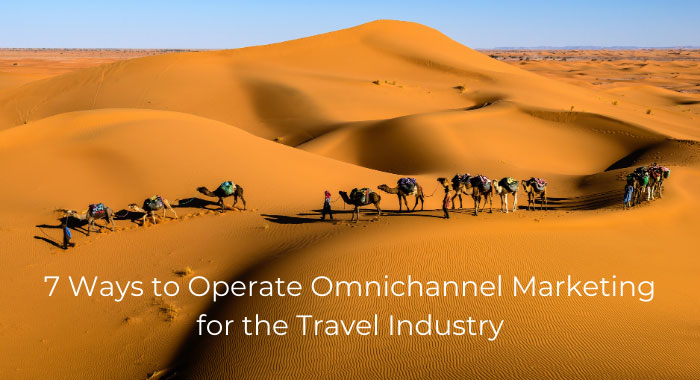Here’s the deal - omnichannel marketing sounds like one of those big strategies that someone else should probably be handling, but hey, maybe it’s worth a try. But we’re not going for standard stuff here, because, honestly, that’s all been done to death. This list? It’s for the travel marketers who just want to mix things up and throw some spaghetti at the wall. Who knows, some of it might stick.
These are some offbeat ideas, so bear with me. It’s not like these are guaranteed to revolutionize anything, but they’re different enough to at least keep things interesting. Here goes.

1. Use Tiny, Random Social Media Platforms for Weirdly Specific Updates
Let’s start by skipping the big platforms everyone’s already on. Instead, there are all kinds of niche, tiny platforms out there where you could randomly start marketing in ways that people haven’t really seen before. It’s not exactly mainstream, but maybe you’ll get people talking (even if it’s just out of curiosity).
- Quirky travel updates on platforms like Letterboxd: Sure, it’s technically for reviewing movies, but nothing’s stopping you from using it as a weird travel log. Why not rate destinations like films? You could rate Paris five stars with a “would visit again” note. It’ll probably confuse people, but maybe it’ll intrigue them too.
- Post scenic shots on Goodreads: Goodreads is for books, but you could sprinkle in travel content by “reviewing” locations as though they were stories. Describe a beach as “an immersive page-turner.” People might not expect it, and maybe that’s where the appeal lies.
- Pinterest boards for only the most obscure local spots: Instead of the usual “Top 10 Beaches,” make boards with highly specific themes, like “Best Gas Stations in Spain.” It’s probably useless, but at least it’ll get a laugh.
It’s all about slipping into places people wouldn’t expect to see travel marketing. And who knows—there’s always a chance someone browsing will actually get curious.
2. Send Postcards…But Don’t Actually Go Anywhere
Nothing says “authentic travel experience” like a postcard, right? But who says you actually need to travel to send them? This low-effort trick is probably going to look way more personalized than it really is. You’re basically faking travel experiences, but in a way that feels kind of quaint.
- Design digital postcards from stock images: Just slap on a photo from Shutterstock, add a generic “Greetings from…” message, and send it out. It’s not exactly genuine, but people might appreciate the touch.
- Use automated postcard services: There are companies that send postcards for you. Customize it a bit, and you’ve got a travel “experience” that doesn’t require a plane ticket.
- Mail followers “handwritten” notes: Write something vague like, “Wish you were here!” and they’ll wonder if it’s real or if you just thought they’d appreciate the charm. Either way, you’re getting their attention.
This might sound a bit lazy, but the randomness of it just might make people smile, which, honestly, is half the battle.
3. Run Contests for Travel Gear…With Ridiculously Random Requirements
Giveaways aren’t new, but here’s the twist: make the requirements as weirdly specific as possible. Instead of standard “like, comment, and share” stuff, throw in requirements that make no sense. People probably won’t know what’s going on, but they might stick around just to see how bizarre it’ll get.
- Ask people to draw something related to travel: Make it something like “draw a stick figure in a place they’ve never been.” People might get confused, but at least it’ll be entertaining.
- Require oddly specific comments: Ask them to comment with their “favorite fictional destination” or “the most overrated landmark.” It’s pointless, but hey, it’s different.
- Invite people to post photos of their travel mishaps: Travel fails are oddly relatable, so people might just participate to share their own funny stories.
The goal here is to make the requirements so random that people have no choice but to engage. They’ll probably remember the strange giveaway even if they don’t actually enter.
Full HD Webcam with Built-in Microphone and Rotatable Tripod
Full HD Video and Wide Angle Lens - The Tewiky High Definition 1080p Webcam features a wide angle lens and delivers crisp clear images and fluid video at 30 frames per second while gaming, video calling, online teaching, live streaming, or recording.
We earn a commission if you click this link and make a purchase at no additional cost to you.
4. Create a Fake Influencer for Your Brand and Let People “Follow” Their Journey
Why bother paying for influencers when you could just make one up? Create an imaginary “traveler” and share “their” adventures across platforms. You could build a whole persona around them and post their “photos” from various destinations. People may end up rooting for your imaginary influencer more than a real one.
- Post vacation photos with funny captions: Use stock images, add captions about “their” adventures, and pretend they’re totally real. People might just play along.
- Invent a backstory with random quirks: Give your influencer weird preferences like “only eats local bread” or “collects rocks from each location.” It adds a bit of odd charm to an otherwise fake profile.
- Let the influencer “interact” with followers: Pretend they’re responding to comments or “planning” their next trip. Who knows, people might actually start requesting fake travel destinations for them to visit.
This idea is a bit silly, but it could give people something to look forward to if they want to see what your imaginary traveler does next.
5. Run a “Virtual Vacation” Series Where You Post As If You’re Traveling
Let’s face it—travel restrictions have made it harder for people to get away. So, why not pretend to travel? Start a series where you “visit” a new place each week, complete with fake itineraries, “local” cuisine reviews, and “sightseeing” recaps. It’s kind of ridiculous, but maybe that’s the point.
- Describe random activities “you did” each day: Write like you actually went zip-lining in Costa Rica or sampled gelato in Italy. People will know it’s fake, but maybe they’ll appreciate the effort.
- Share “souvenir photos” from stock galleries: Use images from a free photo site and claim you “just had to take a picture.” It’s corny, but it could be fun.
- Add random “travel tips” from your “journey”: Throw in random advice like “don’t forget a hat” or “watch out for windy roads.” The sillier, the better.
This virtual vacation thing may not take off in any big way, but it’s a lighthearted way to stay relevant in a time when travel isn’t always an option.

6. Partner with Local Businesses for Bizarre Promo Codes
Collaborations are pretty common, but instead of offering regular discounts, go for something entirely random. Partner with local brands and create promo codes that have nothing to do with travel—just something that might make people laugh or go, “Huh?” It’s more about adding an element of surprise than anything else.
- Offer a promo code like “PineapplePizza20”: This could apply to a beach trip, but it has no connection. It’s silly and probably memorable.
- Use random numbers: Something like “Save72PercentButNotReally” catches the eye for sheer oddity alone. The more confusing, the better.
- Suggest they use the code at random times: Offer discounts only on full moons or odd-numbered days. The randomness might encourage people to give it a shot.
With such bizarre promo codes, you’re likely to get people talking even if they don’t use them. It’s quirky and, if nothing else, a bit more fun than standard discounts.
7. Send Cryptic Email Newsletters
Instead of your standard travel newsletter with clear details and updates, why not try sending out something that leaves people scratching their heads? These newsletters could contain snippets of “travel advice” with no clear context or emails that feel like you’ve sent them to the wrong list.
- Start with lines like “This isn’t the place”: Write confusing intros that make people wonder if they’ve received an accidental email.
- Add random “travel insights”: Drop tips like “always carry a fish in Iceland” with zero explanation. The randomness is half the fun.
- Use mismatched photos and captions: A scenic beach with a caption like “Best Sushi in the City.” It makes no sense, but people might find the absurdity memorable.
These cryptic newsletters may not be the most polished, but they’ll definitely stand out from the usual ones people get, and maybe that’s what will catch their attention.
And there you have it—a totally unpredictable, somewhat ridiculous list of ways to try omnichannel marketing for the travel industry. It’s not your average guide, but maybe that’s the appeal. Give these wacky ideas a shot and see what happens…or don’t. Either way, it’s just about mixing things up and throwing a little fun into the mix.
Did You Know You Already Have A LOT To Sell?
So What's Your Problem?


